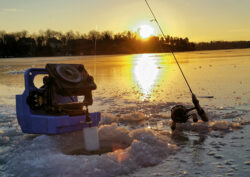Do you really need electronics to ice fish? Years ago, I fished with some great Icemen that would rather fish naked than to leave there Vexillars behind. They would focus on the colored and dancing circles all day, waiting for a bite. With patience, practice, and persistence, their electronics would put fish on the ice.
The problem is that electronics are expensive. A new and advanced Vexillar fish finder can cost from $500-$2,000, or more. They certainly tell the temperature, depth, and other info. Saving a GPS hot spot to identify structure is important.
Icemen fished for centuries without the electronic bells and whistles. Here are some tips!
Look for points of land that stick out into the lake.
Consider shade when locating a hot spot
Look for dams, spillways, or in/outflows
Some structure, trees, stumps, grass that sticks out of the ice
Edges of grass beds can be great spots
Structure like rocks and fallen trees that fall off the shore
Fish the channels
Fish shallow
Use a topographic lake map
Each lake is different. You find different fish in each lake. Consider where the fish feed, suspend, travel, face, or search for food. Different fish feed and need differently. Some prefer light while others prefer shade. Some school fish may be feeding on plankton that settles in deeper channels. Other fish are constantly on the move. Thermoclines tend to be where fish suspend.
Experience will tell you what you need to know. To measure depth, use a sinker and a string. You can mark on the string every foot increment. I used old fly line that had a vinyl coating. It rarely tangled and handled 30 yards of depth. If you know the target depth, from other fishermen, you can zero in on that spot.
Remember that points constrict cruising fish. These choke points mean more fish will pass by your setup. In my experience, hungrier fish tend to be in shallower water. I can also say that in some lakes the fish feed deeper.
There is no better proof of fish than when you catch one. Look for hot holes by examining the ice. Place with blood and bait evidence means there was good fishing. This is a place to start. Don’t be afraid to move. Once you have success, look around for landmarks so you can find the spot later. You will start to notice similarities with why some spots are hotter than others.
Turn on your senses and hook up!
Montana Grant